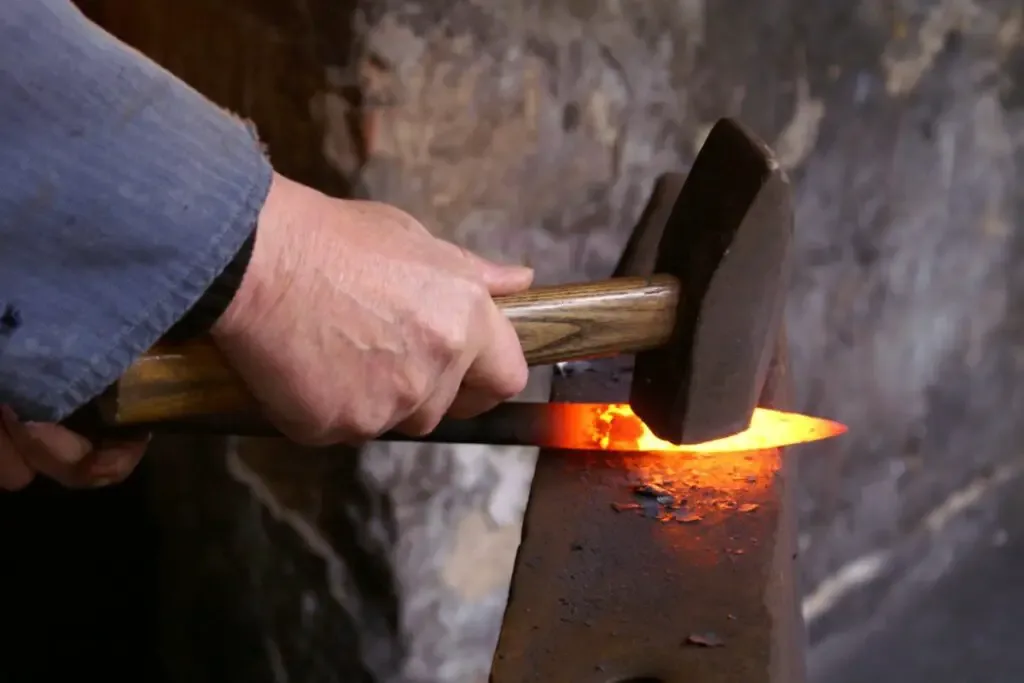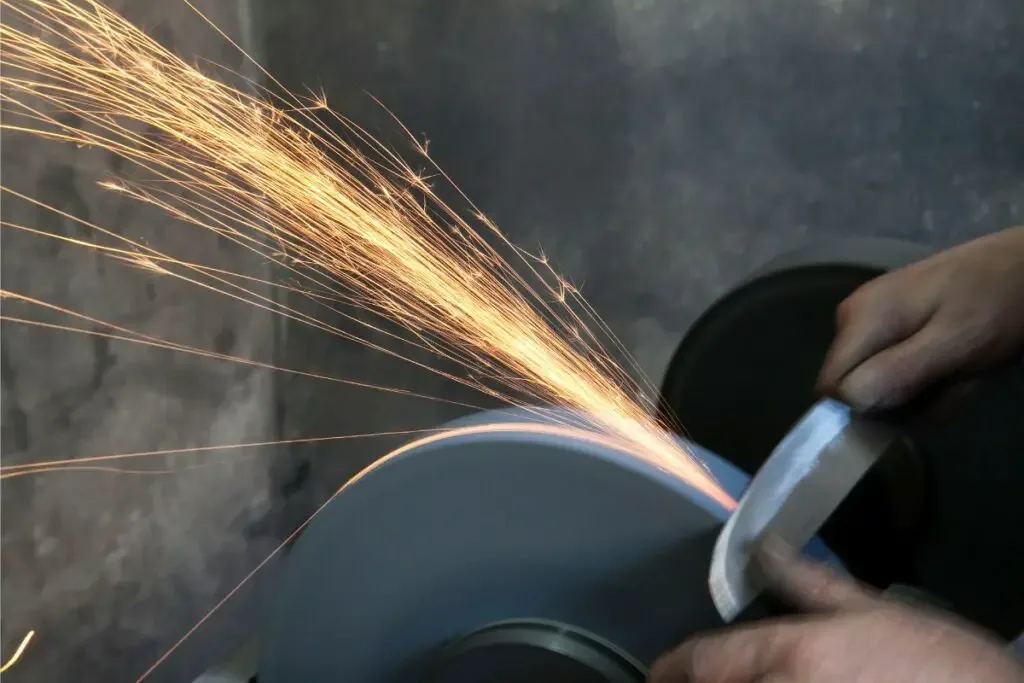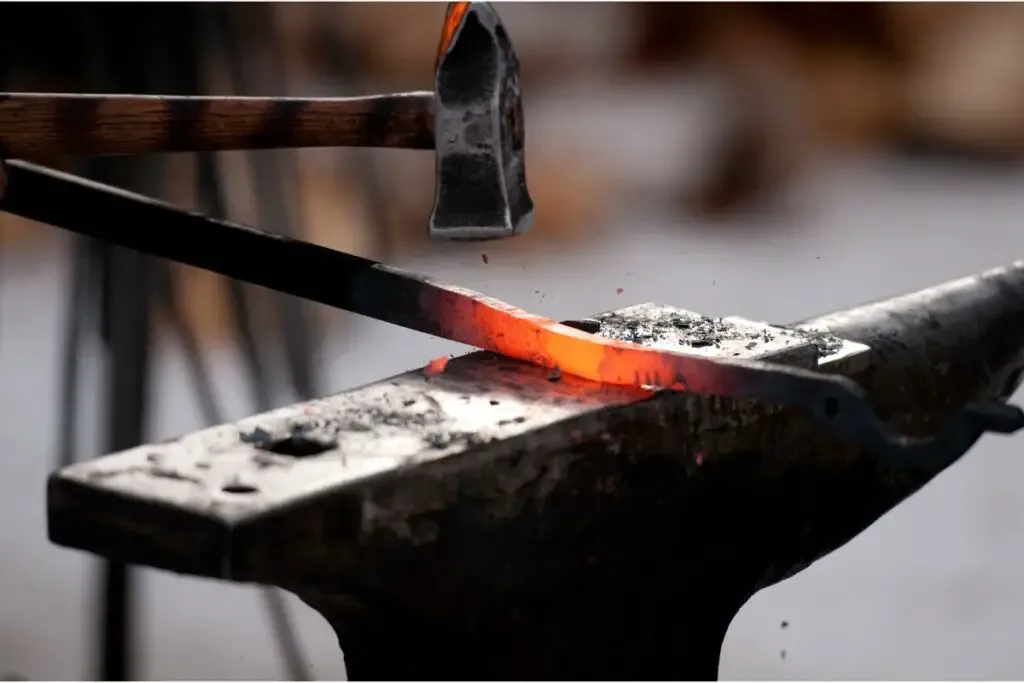As an Amazon Associate, we earn from qualifying purchases with no additional costs for you.
Forging is one way a knife can be produced, and the forging process adds qualities to the metal that is generally lacking in other knife-making methods. The properties that forging adds to the metal translates to the sharp edge as well, which leads to the question of whether you can sharpen a forged knife and if the process differs for knives made using other means.
A forged knife can be sharpened, but the sharpening method may be different from the method used to sharpen other knives. This is due to the characteristics of the steel after the forging process, which makes the steel hard and brittle. The best method for sharpening forged knives is on whetstones.
Forged knives can be sharpened, but the sharpening method that is needed for these hard-steel knives requires more dedication and care to maintain or repair the edge.
Taking shortcuts and using sharpening systems that are intended for softer steel knives will result in frustration and a less-than-desirable outcome for the sharp edge of the knife. We will examine the reasons for this and your best course of action to get your forged knife sharp again!
If you are interested in checking out the best forged knives (made by TOJIRO Japan) we recommend and use, you can find them by clicking here (Amazon link).

Ways Knives Are Made: Forged and Other Methods
The methods that are used to make knives have changed over the years with the introduction of technology, new materials, and new manufacturing techniques. Forging is still used today as one method because of the properties that this method imparts to the steel.
If we take a look at the most common methods of knife making, the differences between the methods will show the differences in the steel and the resulting knife and why different sharpening methods are needed.
- Stamped method for making knives.
Stamped knives are generally mass-produced knives that are cut out from a large sheet of metal. The knife shape is cut out of the metal sheet with a die in much the same way as a cookie-cutter is used to cut out cookie shapes. This process can usually only be used on thinner, softer steel types.
- Stock removal for making knives.
Stock removal is where a piece of metal stock, often in the form of bar stock, is used as the base material for the knife. The knife shape is cut out from the bar-stock with a band saw or angle grinder.
The knife shape is refined on a grinder, and the profiles and edges are ground into steel using the same method. This manufacturing method allows for thicker steel to be used than in the stamped method, and harder steels can be used.
- Forged method for knife making.
This method is where the piece of steel is hammered into the knife shape by heating the metal and pounding it into shape with a hammer on an anvil.
The heating and hammering of the steel change the molecular structure of the steel, creating harder but more brittle steel. Thicker stock can be used in this method, and multiple plates of steel can be used and forged welded together to give the steel different characteristics and properties.
Once the knives have been constructed using any of these three methods, the knife will undergo a process of heat treating and tempering to give the steel the required hardness for the intended purpose of the knife.
The knife will only be able to withstand hardening to a certain HRC, depending on the type of steel that was chosen for the making of the knife.
Forged steels are generally harder and more brittle, which changes how you take care of the steel and the ways that you sharpen the knife.
For convenient reference, we created a comparison table defining the main differences between forged, stamped, and stock removal knives.
| Feature/Aspect | Forged Knives | Stamped Knives | Stock Removal Knives |
| Manufacturing Process | Heated and hammered into shape. | Cut out from a large sheet of metal using a die (similar to a cookie-cutter). | Cut from metal stock using tools like band saws or angle grinders. |
| Steel Hardness | Generally harder due to the forging process. | Softer, as they are usually made from thinner steel sheets. | Can be harder, depending on the type of steel used. |
| Durability | Durable and can hold an edge well. | Might be less durable than forged knives. | Durable, especially if made from high-quality steel. |
| Thickness | Can be thicker due to the forging process. | Generally thinner. | Varies, but can be thicker than stamped knives. |
| Price | Typically more expensive due to the labor-intensive process. | Usually more affordable. | Price varies based on the quality of steel and craftsmanship. |
| Maintenance | Might require specialized sharpening techniques due to hardness. | Easier to sharpen due to softer steel. | Sharpening techniques can vary based on the steel’s hardness. |
| Brittleness | Can be more brittle due to the hardening process. | Less brittle. | Brittleness varies based on the type of steel used. |
| Weight and Balance | Often heavier with a balanced feel. | Lighter in weight. | Weight varies, but often well-balanced. |
| Common Uses | Preferred by professionals for their durability and sharpness. | Common in household settings due to affordability. | Popular among knife enthusiasts and professionals. |
Can A Forged Knife Be Sharpened?

Once the knife has been made, the manufacturer will sharpen the knife before the knife is sent out to the customer. When you receive the knife, it should be sharp and ready to use.
But what happens when you have used the knife for a while and it requires sharpening? Will you be able to sharpen it, or what other action can you take to get the knife sharp again?
A forged knife can definitely be sharpened, but the sharpening method that you choose may be somewhat different from the method used to sharpen other softer steel knives. This is because some sharpening methods will not be effective on the harder forged steel.
This means that while forged knives can be sharpened, it may require a little more work and a different strategy to get them sharp again.
TIP: Wondering why knives can get dull so quickly? Click the article below for the 5 most common reasons!
Why Do Knives Lose Sharpness (So Fast)? 5 Common Reasons
Why Are Forged Knives Difficult To Sharpen?
Forged knives are made by the process of heating and hammering a piece of steel on an anvil until it is shaped like a blade. The heat from this process makes forged blades harder than other types, but they also become more brittle.
This additional hardness of the steel applies to the sharp edge of the blade as well, which changes the dynamic of the way these knives are sharpened.
The sharpening process requires the removal of steel from the edge of the knife to thin out and shape the cutting edge of the knife.
The tools used to sharpen a forged knife will need to be durable and tough enough to cut through the forged hardened steel to sharpen the knife.
What Is The Best Way To Sharpen A Forged Knife?

So, given the fact that forged knives consist of harder steel and any old sharpening system won’t do to get the edge back on these knives, what is the best method to sharpen a forged knife?
The best method for sharpening forged knives is on whetstones. Whetstones allow you to start at an appropriately aggressive grit to cut through the steel quickly to establish the edge. You then progress to higher, finer grit stones to refine, hone and polish the blade to the required sharpness.
Sharpening on a set of whetstones does require the development of this skill to sharpen the forged knives effectively, but it is not impossible to learn.
Sharpening this way also provides a great deal of personal satisfaction once you master the method and produce a beautiful hair-splitting sharp edge on your knives!
TIP: Do you need to sharpen a brand new knife? Find out the answer on how to do it in the article below:
Do You Need To Sharpen A Brand New Knife? Here’s the Answer
Is It Worth The Time And Money To Sharpen Your Own Forged Knives?
One of the characteristics that forging imparts to the steel is that it holds an edge well. However, the steel is brittle and can chip and develop knicks, which will need to be rectified on the blade to maintain sharpness.
As we have already mentioned, sharpening on whetstones is a skill that takes time and practice to acquire, so is it worth the time and money to sharpen your own knives?
It is worth the time and money to sharpen your own knives, even harder to sharpen forged knives. Sharpening your knives yourself will allow you to achieve the edge that you want on your knife, and it will save you time and money in the long run to do this task yourself.
Some of the minor issues on the knife-edge can be resolved by honing on a high grit whetstone or by stropping, but at some point, sharpening will be necessary. At this point, you will need a set of whetstones to get the job done.
You will need a set of whetstones that are in the following grit progressions to achieve a good edge on your forged steel knife.
- A fixing stone, which is a low grit stone of about 140-grit
- 2 sharpening stones, one 400-grit stone, and one 1000-grit stone.
- 1 polishing stone of 6000-grit
If you don’t let the edge of your knife deteriorate to the point that you need a fixing, low-grit stone, you can do away with this option and only get the two sharpening stones and the one polishing stone. Our recommendation would be to choose water stones because they are less messy.
This will give you all the tools that you need to do your own sharpening on your forged steel knives. Once you have purchased your stones, they will last you many years.
If you are diligent in learning to sharpen your knives, you can get to an acceptable skill level in a few weeks. After this point, the time investment in sharpening your own knives will be minimal compared to sending them away to be sharpened.
TIP: Are you looking to buy a new whetstone? Check out our recommendations (we personally use the first three ones):
Our PRO choice whetstones combo (Amazon links):
- Fixing stone: Whetstone SHAPTON Ceramic KUROMAKU #320
- Sharpening stone: Suehiro CERAX soaking whetstone: Medium #1000
- Finishing stone: Whetstone SHAPTON Ceramic KUROMAKU #5000
Our budget choice (Amazon link): Sharp Pebble Extra Large Sharpening Stone Set
Additional Questions About Forged Knives

We have included some additional questions we find that people often ask regarding forged knives.
1. Are forged knives better than stamped knives? “Better” can be subjective. Forged knives are generally more durable, hold an edge longer, and have a balanced feel. However, they are typically more expensive than stamped knives. Stamped knives are lighter and more affordable but might not hold an edge as long. The choice depends on personal preference and intended use.
2. How often should I sharpen my forged knife? It depends on the frequency of use and the tasks you perform with the knife. For regular kitchen use, sharpening every 6-12 months is recommended. However, if you notice any decrease in performance, it might be time for a touch-up.
3. Why are forged knives more expensive? The forging process is labor-intensive and requires skilled craftsmanship. The quality of materials used and the time invested in each knife contribute to the higher cost.
4. Can forged knives rust? Yes, like all knives, forged knives can rust if they are made of carbon steel and not properly cared for. It’s essential to keep them dry and clean. Some forged knives made of stainless steel are more resistant to rust but are not entirely immune.
5. Is there a difference in weight between forged and stamped knives? Generally, forged knives are heavier and have a more balanced feel compared to stamped knives, which are typically lighter.
6. How do I properly care for my forged knife? Always hand wash your forged knife with mild soap and water, dry it immediately, and store it in a knife block or magnetic strip. Avoid putting it in the dishwasher, as the harsh environment can damage the blade and handle.
7. Can I use a honing rod on my forged knife? Yes, using a honing rod regularly can help maintain the knife’s edge and prolong the time between sharpenings. Ensure the rod is suitable for the type of steel your knife is made of.
8. Are all forged knives made of carbon steel? No, while many traditional forged knives are made of carbon steel, they can also be made from stainless steel, high-carbon stainless steel, and other alloys.
Conclusion
If you are the owner of a forged steel knife, you can consider yourself privileged since these knives are durable and great, hard-working knives.
Even though the sharpening process is a little more challenging, forged knives can certainly be sharpened and will hold the edge better than most knives that are constructed using other manufacturing methods.
It is definitely worth the time and the money to learn the skill of sharpening on whetstones so that you can keep your forged steel knife edge in optimal cutting condition!
TIP: People often get confused about what the difference between forged and stamped knives is. Check out the complete guide about forged vs. stamped knives in the article below:
Forged Vs. Stamped Knives: An Honest Comparison
